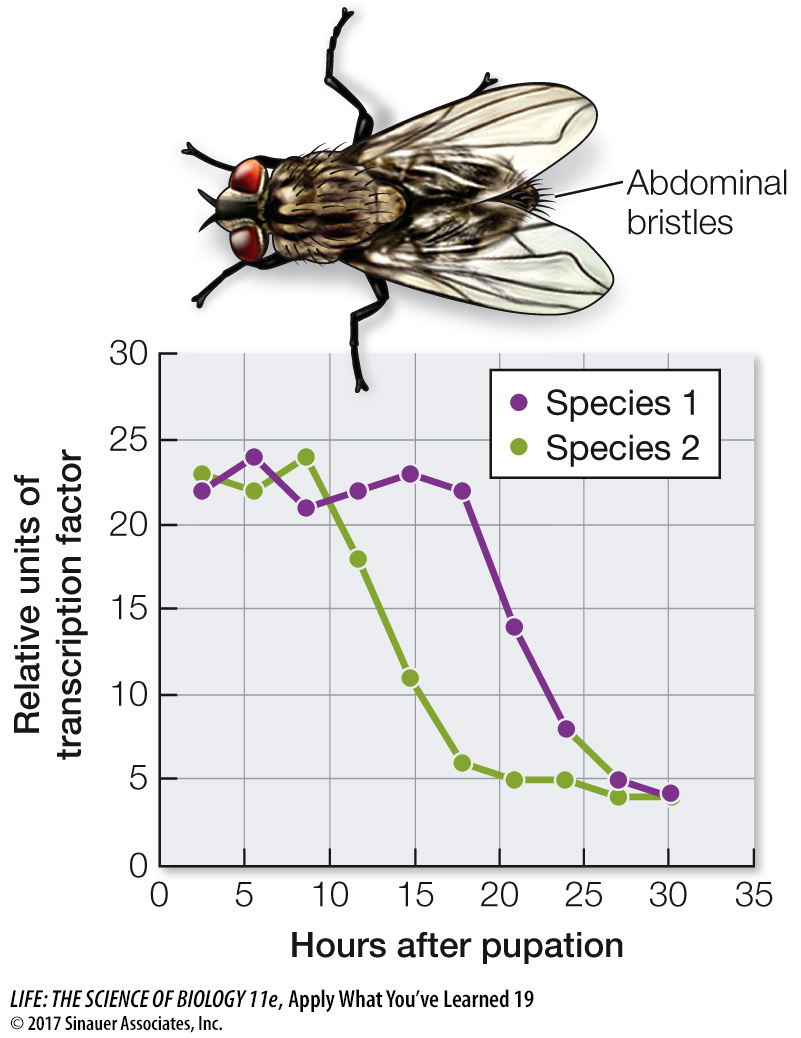Apply What You’ve Learned
Review
19.3
Alterations of Hox genes can result in homeotic mutations.
19.4
Heterochrony has significant importance, as illustrated by the extreme length of a giraffe’s neck.
19.4
Spatial differences in the expression of a developmental gene are known as heterotopy.
19.5
A major developmental change can be caused by an alteration in a regulatory molecule.
Differences in bristle patterns in flies often have implications for how the flies sense the world—
Two hypothetical, closely related fly species differ primarily in the length of bristles on the third segment of the thorax. The transcription factor Hairball is thought to be involved in determining the differences between these structures. The figure below shows the gene expression pattern for both species over the course of time.

Questions
1.
Describe the results and formulate a hypothesis for the role of the transcription factor in the two species. Assess whether this is an example of heterotopy, heterometry, or heterochrony.
The two species differ with respect to how long the transcription factor expression remains high, with the duration of high expression being longer in Species 1. Thus this difference in timing is an example of heterochrony. A reasonable hypothesis is that the morphological difference between the species arises from differential timing of the transcription factor’s expression; specifically, a longer period of high expression (as in Species 1) leads to longer bristles.
2.
Outline an experimental approach that would test the hypothesis generated in Question 1, and provide the expected results.
A direct test of the hypothesis would involve experimental manipulation of the transcription levels in the two species. Increasing the duration of high expression of hairball in Species 2 should result in a bristle size more like that of Species 1. Decreasing the duration of high expression of hairball in Species 1 should result in a bristle size more like that of Species 2.
3.
Bristles ordinarily do not grow on the other two thoracic segments of either of these species, and hairball is not expressed at high levels in these segments. A third species, Species 3, has hairs on the other thoracic segments and expresses hairball during development in these segments. Predict what would happen if hairball were expressed in the other thoracic segments in Species 1 and 2. Assess whether this is an example of heterotopy, heterometry, or heterochrony.
The differences in the presence of bristles in the other segments are likely due to the expression of hairball in those segments. Given that hypothesis, the prediction is that expressing hairball appropriately in those other segments should result in bristles in those segments in Species 1 and 2. This is an example of heterotopy.
4.
Suppose a Hox gene regulates hairball expression, and Species 3 had a variant of the gene that differed by one nucleotide from the variant in Species 1 and 2. How would you test whether this Hox gene was responsible for the differences between Species 3 and Species 1 and 2?
You could express the Hox gene from Species 3 in Species 1 and Species 2 and eliminate the expression of their normal Hox gene. If the differences in the Hox gene are responsible for the bristle pattern difference, then the flies of Species 1 and Species 2 with Species 3 Hox expression should have a bristle pattern like that of Species 3. Similarly, expressing the Species 1 Hox gene in Species 3 should result in a Species 1 bristle pattern in Species 3.